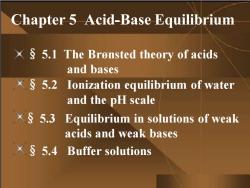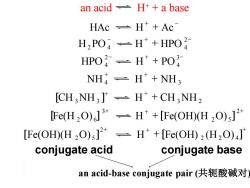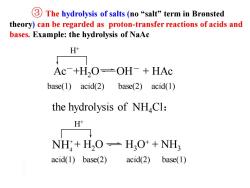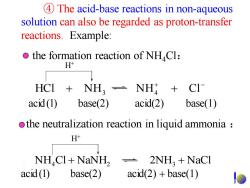北京化工大学:《无机化学》课程电子教案(PPT课件,2013)Chapter 5 Acid-Base Equilibrium

Chapter 5 Acid-Base Equilibrium X$5.1 The Bronsted theory of acids and bases ק5.2 Ionization equilibrium of water and the pH scale X$5.3 Equilibrium in solutions of weak acids and weak bases X 5.4 Buffer solutions
Chapter 5 Acid-Base Equilibrium § 5.4 Buffer solutions § 5.3 Equilibrium in solutions of weak acids and weak bases § 5.2 Ionization equilibrium of water and the pH scale § 5.1 The Brønsted theory of acids and bases

5.5 Acid-bases indicators X 5.6 Lewis acids and bases and coordination compounds X 5.7 Complexation reaction and coordination equilibrium
§ 5.7 Complexation reaction and coordination equilibrium § 5.6 Lewis acids and bases and coordination compounds § 5.5 Acid-bases indicators

5.1 The Bronsted theory of acids and bases 5.1.1 The Bronsted acids and bases -5.1.2 Relative strengths of acids and bases
§ 5.1 The Brønsted theory of acids and bases 5.1.2 Relative strengths of acids and bases 5.1.1 The Brønsted acids and bases

Overview:(sour,bitter)Taste-→Arrhenius theory(酸碱电离理论, Ht&OHr),→Solvent theory,,Bronsted theory(质子理论),Lewis theory(电子理论),soft-hard acid/.base theory.… 5.1.1 The Bronsted theory of acids and bases(酸碱质子理论) acid:a substance capable of donating a proton.(proton donor) (质子的给予体) base:a substance that can accept a proton.(proton acceptor) (质子的接受体)
acid: a substance capable of donating a proton. (proton donor) (质子的给予体) base: a substance that can accept a proton. (proton acceptor) (质子的接受体) 5.1.1 The Brønsted theory of acids and bases (酸碱质子理论) Overview: (sour, bitter)Taste→ Arrhenius theory(酸碱电离理论, H+&OH- ), → Solvent theory, Bronsted theory(质子理论), Lewis theory(电子理论), soft-hard acid/base theory…

an acid 之 H++a base HAc±H++Ac H2PO-H*+HPO2 HPO-H'+PO NHH*+NH3 [CH NH3]*=H*+CH NH2 [Fe(H2O)]*-H*+[Fe(OH)(H2O);]2* [Fe(OH)(H2O)s]2-H*+[Fe(OH)2(H2O)4] conjugate acid conjugate base an acid-base conjugate pair(共轭酸碱对
an acid H+ + a base + - HAc H + Ac - + - + 2 H2PO 4 H HPO 4 - + - + 3 4 2 HPO 4 H PO + + + NH 4 H NH 3 [ ] + + + CH 3NH 3 H CH 3NH 2 + + + + 2 2 5 3 [Fe(H 2O) 6 ] H [Fe(OH)(H O) ] + + + + 2 2 4 2 [Fe(OH)(H 2O) 5 ] H [Fe(OH) (H O) ] conjugate acid conjugate base an acid-base conjugate pair (共轭酸碱对)

amphiprotic substance(两性物质): a substance that can either donate or accept a proton is said to be amphiprotic. Example:HSO,[Fe(OH)(H2O)s]2+,HCO3,H2O,HS-etc the essence of acid-base reaction in Bronsted theory is proton transfer between two acid-base conjugate pairs,examples are given below:
amphiprotic substance(两性物质): a substance that can either donate or accept a proton is said to be amphiprotic. HCO3 - , H2O, HS- [Fe(OH)(H2O)5 ] etc 2+ HSO , 4 - Example: , the essence of acid-base reaction in Brønsted theory is proton transfer between two acid-base conjugate pairs, examples are given below:

1The ionization reactions of acids and bases in solvent are proton-transfer reactions. Example:the ionization of HF in water can be represented as HF(ag)-H++F(aq) H++H2O(1)-H3O*(aq) HF(aq)+H2O(1)=H3O*(aq)+F(aq) 2Water is an amphiprotic substance,its autoionization is also proton-transfer reaction. H H2O(1)+H2O(1)-H3O*(aq)+OH-(aq) acid(1)base(2) acid(2) base(1)
① The ionization reactions of acids and bases in solvent are proton-transfer reactions. Example: the ionization of HF in water can be represented as ② Water is an amphiprotic substance, its autoionization is also proton-transfer reaction. H+ acid(1) base(2) acid(2) base(1) HF(aq) H+ + F-(aq) H+ + H2O(l) H3O+ (aq) HF(aq) + H2O(l) H3O+ (aq) + F-(aq) H2O(l)+H2O(l) H3O+ (aq) +OH-(aq)

③The hydrolysis of salts(no“salt”term in Bronsted theory)can be regarded as proton-transfer reactions of acids and bases.Example:the hydrolysis of NaAc H Ac+H,O=OH-+HAc base(1)acid(2)base(2)acid(1) the hydrolysis of NHCl: H中 NH:+H2O=H2O++NH3 acid(1)base(2) acid(2) base(1)
③ The hydrolysis of salts (no “salt” term in Brønsted theory) can be regarded as proton-transfer reactions of acids and bases. Example: the hydrolysis of NaAc base(1) acid(2) base(2) acid(1) H+ the hydrolysis of NH4Cl: acid(1) base(2) acid(2) base(1) H+ Ac-+H2O OH- + HAc + H2O H3O+ + NH3 + NH4

4 The acid-base reactions in non-aqueous solution can also be regarded as proton-transfer reactions.Example: the formation reaction of NHCl: H HCI+ NH NHA C1 acid(1) base(2) acid(2) base(1) the neutralization reaction in liquid ammonia H NH CI+NaNH, 2NH,NaCl acid(1) base(2) acid(2)+base(1)
④ The acid-base reactions in non-aqueous solution can also be regarded as proton-transfer reactions. Example: the formation reaction of NH4Cl: H+ the neutralization reaction in liquid ammonia : H+ + - HCl + N H N H + Cl 3 4 NH Cl NaNH 2NH NaCl 4 + 2 3 + acid(1) base(2) acid(2) base(1) acid(1) base(2) acid(2) + base(1)

5.1.2 Relative strengths of acids and bases The strength of an acid or a base refers to the ability of donating proton for an acid or accepting proton for a base. HAc HCN HCI, HNO3 K8 1.8×10-5 5.8×10-10 H-Cl: differentiating effect(区分效应): e.g.:H2O can differentiate the relative strength of HAc,HCN. leveling effect(拉平效应):a solvent's ability to level the effect of a strong acid or base dissolved in it
HAc HCN differentiating effect(区分效应): e.g.:H2O can differentiate the relative strength of HAc,HCN. leveling effect(拉平效应):a solvent's ability to level the effect of a strong acid or base dissolved in it. The strength of an acid or a base refers to the ability of donating proton for an acid or accepting proton for a base. 5.1.2 Relative strengths of acids and bases 1.8×10 K -5 a 5.8×10-10 HCl, HNO3
按次数下载不扣除下载券;
注册用户24小时内重复下载只扣除一次;
顺序:VIP每日次数-->可用次数-->下载券;
- 北京化工大学:《无机化学》课程电子教案(PPT课件,2013)Chapter 2 Thermochemistry.ppt
- 北京化工大学:《无机化学》课程电子教案(PPT课件,2013)Chapter 1 Preface.ppt
- 北京化工大学:《无机化学》课程电子教案(教学课件,2012)Chapter 8 Atomic Structure.pdf
- 北京化工大学:《无机化学》课程电子教案(教学课件,2012)Chapter 7 Redox Reactions and the Base of Electrochemistry.pdf
- 北京化工大学:《无机化学》课程电子教案(教学课件,2012)Chapter 6 Precipitation-Solubility Equilibria.pdf
- 北京化工大学:《无机化学》课程电子教案(教学课件,2012)Chapter 5 Acid-Base Equilibrium.pdf
- 北京化工大学:《无机化学》课程电子教案(教学课件,2012)Chapter 2 Thermochemistry.pdf
- 北京化工大学:《无机化学》课程电子教案(教学课件,2011)Chapter 16 The d-block elements(Ⅰ).pdf
- 北京化工大学:《无机化学》课程电子教案(教学课件,2011)Chapter 15 p-block elements(Ⅲ).pdf
- 北京化工大学:《无机化学》课程电子教案(教学课件,2011)Chapter 14 p-block elements(Ⅱ).pdf
- 北京化工大学:《无机化学》课程电子教案(教学课件,2011)Chapter 17 The d-block elements(Ⅱ).pdf
- 北京化工大学:《无机化学》课程电子教案(教学课件,2011)Chapter 09 Molecular Structure.pdf
- 北京化工大学:《无机化学》课程电子教案(教学课件,2011)Chapter 07 Redox Reactions and Base of Electrochemistry.pdf
- 北京化工大学:《无机化学》课程电子教案(教学课件,2011)Chapter 13 The p-block elements(Ⅰ).pdf
- 北京化工大学:《无机化学》课程电子教案(教学课件,2011)Chapter 08 Atomic Structure.pdf
- 北京化工大学:《无机化学》课程电子教案(教学课件,2011)Chapter 06 Precipitation-Solubility Equilibria.pdf
- 北京化工大学:《无机化学》课程电子教案(教学课件,2011)Chapter 12 The s-Block Elements.pdf
- 北京化工大学:《无机化学》课程电子教案(教学课件,2011)Chapter 11 Coordination Compound Structures.pdf
- 北京化工大学:《无机化学》课程电子教案(教学课件,2011)Chapter 10 Solid Structure.pdf
- 北京化工大学:《无机化学》课程电子教案(教学课件,2011)Chapter 04 Chemical equilibria, entropy and Gibbs function.pdf
- 北京化工大学:《无机化学》课程电子教案(PPT课件,2013)Chapter 6 Precipitation-Solubility Equilibria.ppt
- 北京化工大学:《无机化学》课程电子教案(PPT课件,2013)Chapter 4 Chemical equilibria, entropy and Gibbs function.ppt
- 北京化工大学:《无机化学》课程电子教案(教学课件,2012)Chapter 4 Chemical equilibria, entropy and Gibbs function.pdf
- 北京化工大学:《无机化学》课程电子教案(PPT课件,2013)Chapter 10 Solid Structure.pptx
- 北京化工大学:《无机化学》课程电子教案(PPT课件,2013)Chapter 11 Coordination Compound Structures.ppt
- 北京化工大学:《无机化学》课程电子教案(PPT课件,2013)Chapter 12 The s-Block Elements.pptx
- 北京化工大学:《无机化学》课程电子教案(PPT课件,2013)Chapter 13 The p-block elements(Ⅰ).ppt
- 北京化工大学:《无机化学》课程电子教案(PPT课件,2013)Chapter 14 Chapter 14 The p-block elements(Ⅱ).ppt
- 北京化工大学:《无机化学》课程电子教案(PPT课件,2013)Chapter 15 The p-block elements(Ⅲ).ppt
- 北京化工大学:《无机化学》课程电子教案(PPT课件,2013)Chapter 16 The d-block elements(Ⅰ).ppt
- 北京化工大学:《无机化学》课程电子教案(PPT课件,2013)Chapter 7 Redox Reactions and the Base of Electrochemistry.ppt
- 北京化工大学:《无机化学》课程电子教案(PPT课件,2013)Chapter 8 Atomic Structure.ppt
- 北京化工大学:《无机化学》课程电子教案(PPT课件,2013)Chapter 9 Molecular Structure.ppt
- 北京化工大学:《无机化学》课程电子教案(课件讲稿,2015)Chapter 1 Preface(负责人:周云山).pdf
- 北京化工大学:《无机化学》课程电子教案(课件讲稿,2015)Chapter 2 Basic of thermodynamics.pdf
- 北京化工大学:《无机化学》课程电子教案(课件讲稿,2015)Chapter 4 Chemical equilibria.pdf
- 北京化工大学:《无机化学》课程电子教案(课件讲稿,2015)Chapter 5 Atomic Structure.pdf
- 北京化工大学:《无机化学》课程电子教案(课件讲稿,2015)Chapter 6 Molecular Structure and covalent bond theory.pdf
- 北京化工大学:《无机化学》课程电子教案(课件讲稿,2015)Chapter 7 Crystal Structure.pdf
- 北京化工大学:《无机化学》课程电子教案(课件讲稿,2015)Chapter 8 Acid-Base Equilibrium.pdf
